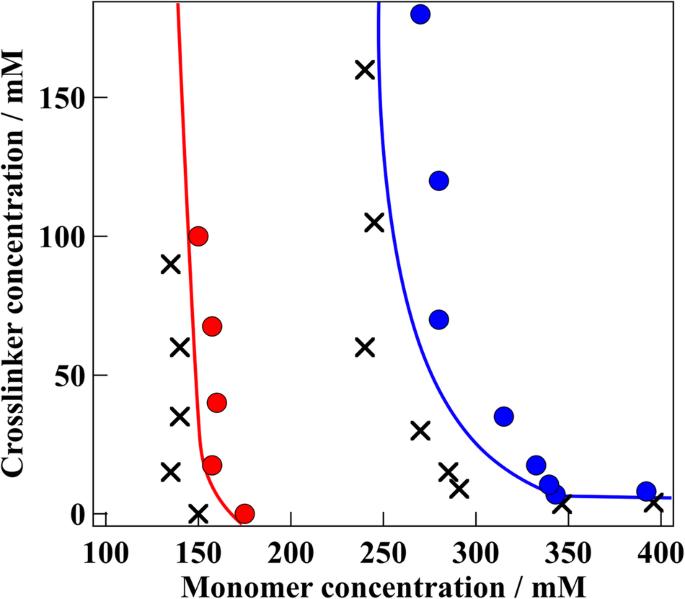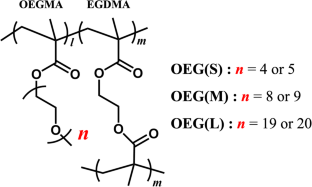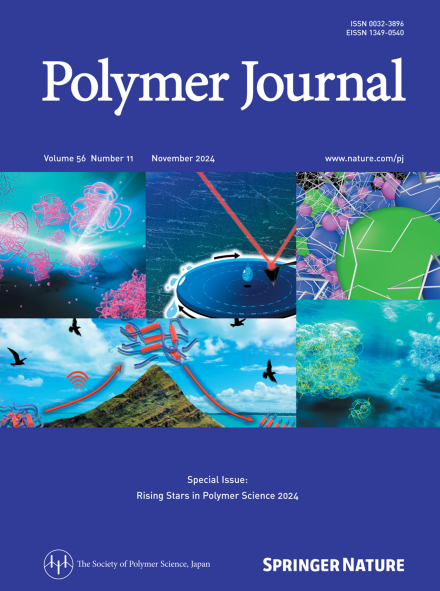Phase diagram for the gelation of temperature-responsive and biocompatible poly(oligo ethylene glycol methyl ether methacrylate) polymers in aqueous free-radical polymerization reactions
IF 2.3
4区 化学
Q3 POLYMER SCIENCE
引用次数: 0
Abstract
In this study, gel-phase diagrams of temperature-responsive and biocompatible polymers were obtained, and the characteristic gelation behaviors of the polymers were examined. The polymers are based on three oligoethylene glycol methyl ether methacrylate (OEGMA) monomers with different numbers of ethylene oxide (EO) units, i.e., with side chains that differ in length. The gelation thresholds depend on the OEGMA and crosslinker concentrations as well as the side chain length. Long EO side chains fill the polymerization system and reduce the concentration of polymer overlap, resulting in a high ability to occupy the system. Furthermore, the EO side chains may engage in self-crosslinking, i.e., polymers can branch and grow from the side chains depending on their length, resulting in a high bond probability. Based on these unique behavior patterns, gelation occurs more readily as the length of the side chains increases. We also synthesized ultralow crosslinked pOEGMA gels by tuning the gelation conditions; these gels exhibited improved swelling capacity and temperature responsiveness. These results should facilitate the development of a synthesis strategy to control the physical properties and structures of these materials for advanced applications, such as biofilms, actuators, and carriers. The gel-phase diagrams of temperature-responsive and biocompatible polymers with ethylene oxide (EO) side chains that differ in length were obtained. The gelation thresholds of the polymers depend not only on the monomer and crosslinker concentrations but also on the EO side chain lengths. Long EO side chains reduce the polymer overlap concentration. Furthermore, the EO side chains can engage in self-crosslinking, i.e., polymers can grow from the side chains depending on their length. These unique behaviors indicate that gelation occurs more readily with increasing the side chain length.


水基自由基聚合反应中温度响应型生物兼容聚(低聚乙二醇甲醚甲基丙烯酸酯)聚合物凝胶化的相图
本研究获得了具有温度响应性和生物相容性的聚合物的凝胶相图,并研究了这些聚合物的凝胶化特性。这些聚合物基于三种具有不同环氧乙烷(EO)单元数(即侧链长度不同)的低聚乙二醇甲醚甲基丙烯酸酯(OEGMA)单体。凝胶化阈值取决于 OEGMA 和交联剂的浓度以及侧链的长度。长的 EO 侧链可填充聚合体系,降低聚合物重叠的浓度,从而提高占据体系的能力。此外,环氧乙烷侧链可能会发生自交联,即聚合物会根据侧链的长度发生分支和生长,从而产生较高的键合概率。基于这些独特的行为模式,随着侧链长度的增加,凝胶化更容易发生。我们还通过调整凝胶化条件合成了超低交联 pOEGMA 凝胶;这些凝胶显示出更强的溶胀能力和温度响应性。这些结果将有助于开发一种合成策略,以控制这些材料的物理性质和结构,从而应用于生物膜、致动器和载体等先进领域。
本文章由计算机程序翻译,如有差异,请以英文原文为准。
求助全文
约1分钟内获得全文
求助全文
来源期刊

Polymer Journal
化学-高分子科学
CiteScore
5.60
自引率
7.10%
发文量
131
审稿时长
2.5 months
期刊介绍:
Polymer Journal promotes research from all aspects of polymer science from anywhere in the world and aims to provide an integrated platform for scientific communication that assists the advancement of polymer science and related fields. The journal publishes Original Articles, Notes, Short Communications and Reviews.
Subject areas and topics of particular interest within the journal''s scope include, but are not limited to, those listed below:
Polymer synthesis and reactions
Polymer structures
Physical properties of polymers
Polymer surface and interfaces
Functional polymers
Supramolecular polymers
Self-assembled materials
Biopolymers and bio-related polymer materials
Polymer engineering.
 求助内容:
求助内容: 应助结果提醒方式:
应助结果提醒方式:


